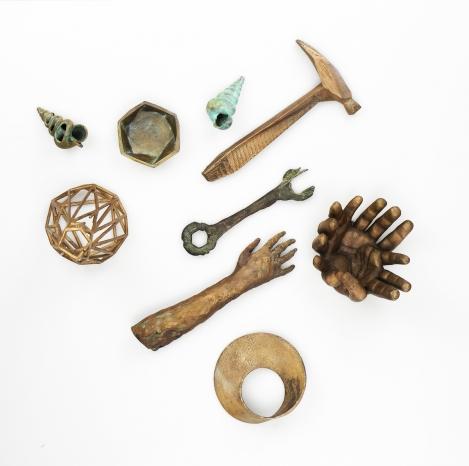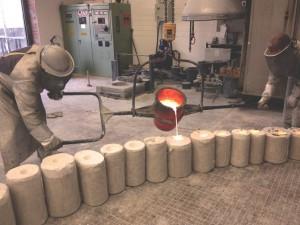 As human creations, the machines we make and systems we put in place are of course imperfect. Media artists Jan Sengstake and Vincent Brinkmann, both students at the University of Arts in Bremen, Germany, explored this subject as an extension of their study in the relationships between man and machine, which we reported on previously in connection with their EXtrace clay 3D printer.
As human creations, the machines we make and systems we put in place are of course imperfect. Media artists Jan Sengstake and Vincent Brinkmann, both students at the University of Arts in Bremen, Germany, explored this subject as an extension of their study in the relationships between man and machine, which we reported on previously in connection with their EXtrace clay 3D printer.
Looking at not only all the new layers of technology and information available to us today, they stopped in the more literal sense to actually look at the layers, imperfections, and glitches themselves–being produced by the 3D printing process itself.
In a recent workshop, 3D Printing and Casting, the artists have turned our expectation for perfection on its ear. Laying down the idea that manufactured products must be fixed and refined to meet the judging eyes of the consuming public, they instead discuss the obvious in that most objects evolve from a digital format which is responsible for a variety of material imperfections along the way, for whatever reason. Sengstake and Brinkmann want to look at these imperfections, pertaining to 3D printing, as influencing and contributing to the design itself.
“As almost all objects have their origin in the digital world in the conceptual phase, constructing process, and media representation, we wanted to focus on artefacts and errors in this process,” Brinkmann told 3DPrint.com. “We set up a workshop dealing with glitches made by modeling and scanning software, not ignoring or repairing them, but seeing glitches as an influence from the digital to the physical.”
While casting 3D prints in boiling bronze metal, the artists deliberately produced glitches, with the help of specific algorithms and 3D modeling software. Using ABS 3D printing filament because it gave them better results, the artists were able to clearly ‘contemplate’ their project using the lost wax casting method in their workshop.
“We mainly used the common printer material ABS as it’s made out of crude oil,” said Brinkmann. “ABS easily burns out without remnants when preparing the molds for casting in the oven. Objects made out of PLA are also suitable but have a weaker performance with thinner models.”
The artists begin by 3D printing a model which is then encased in a plaster mold. It’s then placed in an oven and heated until all the plastic and wax is burned away. At that point, almost employing a negative space ideal, all that is left is the cavity–in the shape of the 3D printed object. This is the space they fill with boiling aluminum or bronze which hardens upon cooling.
 Once the casts have hardened, they are ‘beaten’ out of the molds and then treated with different chemicals to initiate colorization in the metal and also offer protection from corrosion.
Once the casts have hardened, they are ‘beaten’ out of the molds and then treated with different chemicals to initiate colorization in the metal and also offer protection from corrosion.
Their interest is in the lines left by the 3D printer during the layering process.
“You can still see the isolines and the layered structure of the 3D-printed objects. Is this the beginning of a new design aesthetic?” questions Brinkmann. “The casting with 3D prints only distinguishes in the preparation process from the traditional casting techniques.”
It’s an interesting contrast studying the textures and ‘glitches’ made during the technical and artistic process, which would be an interesting concept used in many other realms besides 3D printing. While often art is simply about interesting and sometimes curious aesthetics, the workshop provided by Sengstake and Brinkmann offers a provocative look into the future of one area of industrial design.
Since the inception of more high-tech advances like robotics and computers–and really, harkening back to the popularity of Mary Shelley’s horror novel Frankenstein, man has had an ongoing conversation and concern regarding his relationship with technology. Although it’s really just an extension of ourselves, as our own creation, there is a fascination, a fear–and a love/hate relationship as we consider its threat, implications, conveniences, and inconveniences therein as well.
There couldn’t be a topic more ripe for discussion and as subject matter in the art world, where we often see the bravest and most thoughtful innovations and expressions about the nuances of smart technology. This discussion on the influences of imperfections and glitches caused during the work process offers numerous inspiring questions.
Workshop participants were: Christine Brovkina, Dustin Sherman, Eran Amir, Felix Fisgus, Joris Holte, Jonas Holst, Lennard Ulrich, Marcel Vesga, Sven Rose, and Thomas Hoheisel.

Subscribe to Our Email Newsletter
Stay up-to-date on all the latest news from the 3D printing industry and receive information and offers from third party vendors.
Print Services
Upload your 3D Models and get them printed quickly and efficiently.
You May Also Like
Consolidation in AM: How 2025 Is Shaping the Industry’s New Normal
The first half of 2025 has been marked by a clear shift in the additive manufacturing (AM) industry. Companies are no longer just focused on developing new tech by themselves....
Etsy Design Rule Change Reduces Selection of 3D Printed Goods
Online marketplace Etsy has implemented a rule change requiring all 3D printed goods on the site to be original designs. The update to the site’s Creativity Standards states, ¨Items produced using...
U.S. Congress Calls Out 3D Printing in Proposal for Commercial Reserve Manufacturing Network
Last week, the U.S. House of Representatives’ Appropriations Committee moved the FY 2026 defense bill forward to the House floor. Included in the legislation is a $131 million proposal for...
Transforming From Tourist to Native: Duro CEO Michael Corr Explains Why the Company Rebuilt its PLM Software on AI
In these early innings of the AI boom, many market analysts have expressed concern that AI spend has gotten too far ahead of the technology’s proven ability to deliver significant...
































